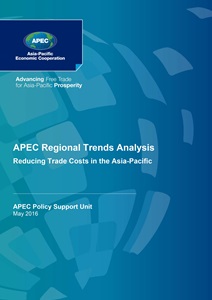APEC Regional Trends Analysis

| Published Date | May 2016 |
|---|---|
| Type of Publication | Reports |
| Publication Under | APEC Secretariat, APEC Policy Support Unit |
| Accessed | 19445 |
| Pages | 30 |
| Download publication | Download |
Description
May 2016 Issue
APEC Regional Trends Analysis is a new publication of the PSU, combining two former reports “APEC Economic Trends Analysis and Key Trends” and “Developments Relating to Trade and Investment Measures”.
The theme chapter addresses the topic on reducing trade costs in the Asia-Pacific. While measurements show that trade costs in APEC economies have decreased significantly between 2010 and 2014, there is a need to further understand the nature of these trade costs and why they have been falling. APEC has made considerable efforts to reduce trade costs, and more can be done to enhance these efforts.
The next chapter analyses the economic, trade and investment situation in the APEC region. Among the key findings are:
• APEC GDP grew by 2.7% in 2015, lower than the 2014 growth of 2.9%.
• Resilient private consumption and strong government spending boosted economic activity in the APEC region throughout 2015.
• A downturn in trade was seen in the APEC region in 2015, reflecting the impact of a confluence of cyclical and structural factors.
• Preliminary estimates show that APEC economies were the top three largest recipients of FDI inflows in 2015.
• APEC implemented more trade-related measures that had the effect of discouraging trade (mid-May to mid-October 2015) and more measures to ease the entry of FDI (May 2015 to February 2016).
• Based on IMF growth projections, APEC region will maintain a 2.7% growth in 2016, inching up to 2.8% in 2017-2018.
APEC Regional Trends Analysis is a new publication of the PSU, combining two former reports “APEC Economic Trends Analysis and Key Trends” and “Developments Relating to Trade and Investment Measures”.
The theme chapter addresses the topic on reducing trade costs in the Asia-Pacific. While measurements show that trade costs in APEC economies have decreased significantly between 2010 and 2014, there is a need to further understand the nature of these trade costs and why they have been falling. APEC has made considerable efforts to reduce trade costs, and more can be done to enhance these efforts.
The next chapter analyses the economic, trade and investment situation in the APEC region. Among the key findings are:
• APEC GDP grew by 2.7% in 2015, lower than the 2014 growth of 2.9%.
• Resilient private consumption and strong government spending boosted economic activity in the APEC region throughout 2015.
• A downturn in trade was seen in the APEC region in 2015, reflecting the impact of a confluence of cyclical and structural factors.
• Preliminary estimates show that APEC economies were the top three largest recipients of FDI inflows in 2015.
• APEC implemented more trade-related measures that had the effect of discouraging trade (mid-May to mid-October 2015) and more measures to ease the entry of FDI (May 2015 to February 2016).
• Based on IMF growth projections, APEC region will maintain a 2.7% growth in 2016, inching up to 2.8% in 2017-2018.

